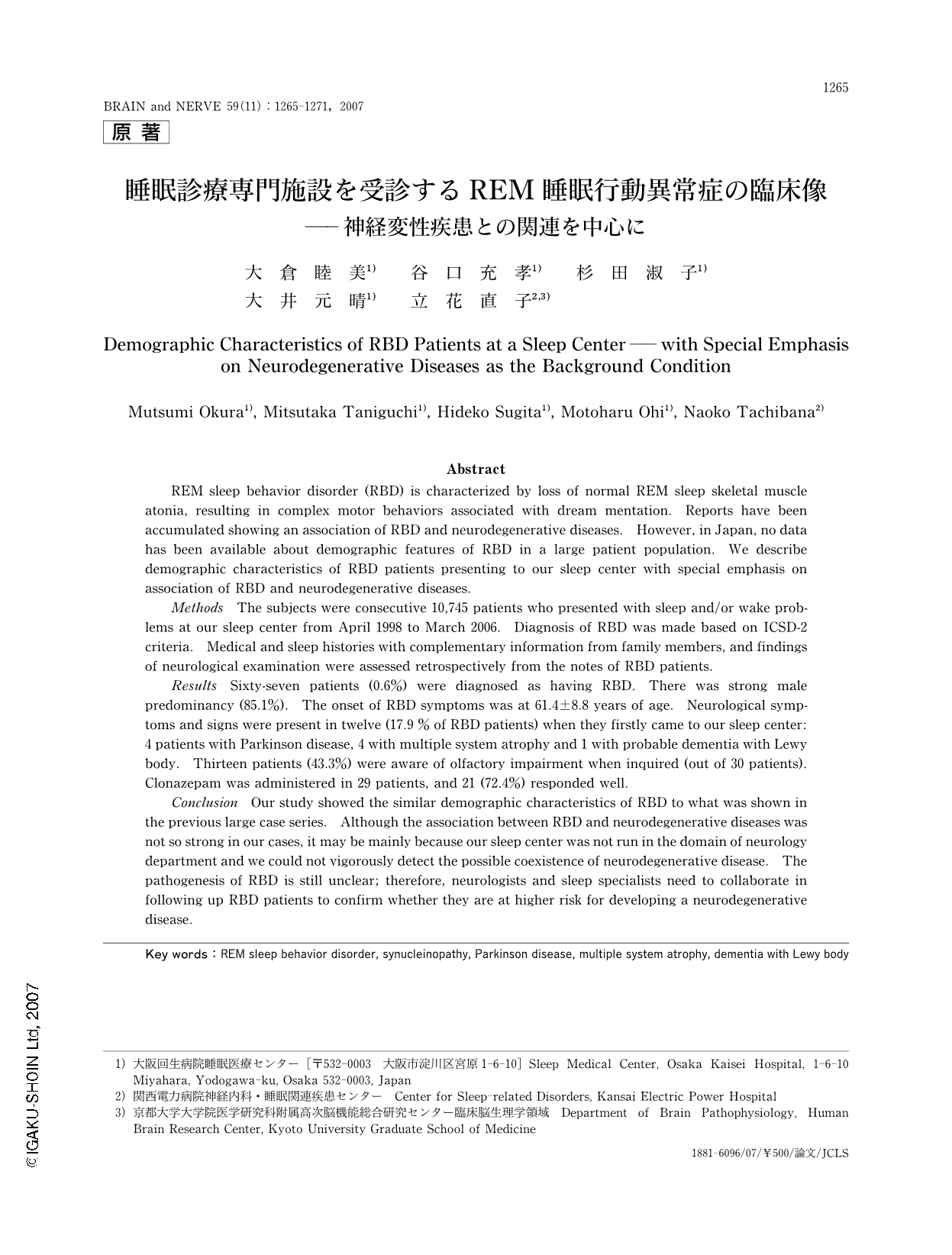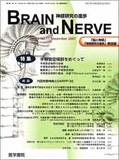Japanese
English
- 有料閲覧
- Abstract 文献概要
- 1ページ目 Look Inside
- 参考文献 Reference
はじめに
REM睡眠行動異常症(rapid eye movement (REM) sleep behavior disorder: RBD)は,REM睡眠中に起こる睡眠随伴症(パラソムニア)の1つである1)。通常REM睡眠中は抗重力筋の筋緊張が低下し,動けないようになっているが,RBDにおいては筋緊張が低下しないために夢内容に一致した行動が出現すると考えられている2)。したがって,RBDの終夜睡眠ポリグラフ検査(polysonography: PSG)上の特徴は,REM睡眠期に筋活動が十分抑制されないことであり,筋活動抑制を伴わないREM睡眠(REM sleep without atonia: RWA)と呼ばれている特殊な睡眠状態が出現することである。
一方,最近RBDがパーキンソン病(Parkison disease: PD),多系統萎縮症(multiple system atrophy: MSA),レヴィ小体認知症(dementia with Lewy body: DLB)などのsynucleionapathyの前駆症状もしくは初期の症状として出現するという報告がみられ,海外よりの多数の報告例や治療報告がなされている3,4)。しかし本邦ではPSGを施行し得る施設が限られており,特にパラソムニアを対象にPSGを実施できる施設が少ない現状のため,RBDの臨床特徴について検討した報告はない。
さらに原因疾患が特定できない特発性RBDとされている症例においても,神経学的徴候は認められないが,脳機能画像上の異常所見が検出されることがあるため,“cryptogenic RBD”として捉えようとする考えも提唱されており,神経変性疾患との関与を調べることが重要となってきている5)。
今回,われわれは一般病院睡眠センター開設以来RBDと診断した症例の全例についてまとめ,臨床的背景や神経変性疾患との関連について検討した。
Abstract
REM sleep behavior disorder (RBD) is characterized by loss of normal REM sleep skeletal muscle atonia, resulting in complex motor behaviors associated with dream mentation. Reports have been accumulated showing an association of RBD and neurodegenerative diseases. However, in Japan, no data has been available about demographic features of RBD in a large patient population. We describe demographic characteristics of RBD patients presenting to our sleep center with special emphasis on association of RBD and neurodegenerative diseases.
Methods The subjects were consecutive 10,745 patients who presented with sleep and/or wake problems at our sleep center from April 1998 to March 2006. Diagnosis of RBD was made based on ICSD-2 criteria. Medical and sleep histories with complementary information from family members, and findings of neurological examination were assessed retrospectively from the notes of RBD patients.
Results Sixty-seven patients (0.6%) were diagnosed as having RBD. There was strong male predominancy (85.1%). The onset of RBD symptoms was at 61.4±8.8 years of age. Neurological symptoms and signs were present in twelve (17.9 % of RBD patients) when they firstly came to our sleep center: 4 patients with Parkinson disease, 4 with multiple system atrophy and 1 with probable dementia with Lewy body. Thirteen patients (43.3%) were aware of olfactory impairment when inquired (out of 30 patients). Clonazepam was administered in 29 patients, and 21 (72.4%) responded well.
Conclusion Our study showed the similar demographic characteristics of RBD to what was shown in the previous large case series. Although the association between RBD and neurodegenerative diseases was not so strong in our cases, it may be mainly because our sleep center was not run in the domain of neurology department and we could not vigorously detect the possible coexistence of neurodegenerative disease. The pathogenesis of RBD is still unclear; therefore, neurologists and sleep specialists need to collaborate in following up RBD patients to confirm whether they are at higher risk for developing a neurodegenerative disease.

Copyright © 2007, Igaku-Shoin Ltd. All rights reserved.


